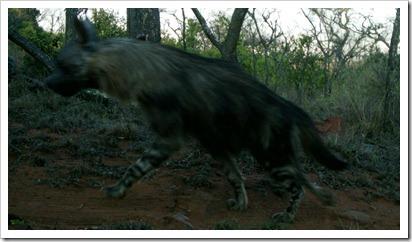Hi everyone. It’s Katy Williams here.
In October 2012 I began my PhD on human-brown hyaena relationships in the Soutpansberg Mountains. I was extremely lucky to gain financial support for the research from Durham University, individuals who supported my SciFund Challenge funding bid and an independent donor from the states.
I stayed in Durham for the first 2.5 months of my PhD and used this time to review relevant literature and gain advice from my supervisors which enabled me to prepare for the fieldwork.

Since December I have been very busy both in my role as Field Team Leader for the Primate and Predator Project but also with my PhD research. I want to use this blog post as an opportunity to update readers with the aim of the research. So here’s an abstract about what I am aiming to achieve:
In southern Africa the brown hyaena (Hyaena brunnea), a nocturnal and seldom seen carnivore, is perceived from a wide variety of contrasting social perspectives. The animal is viewed both through imaginary constructs stemming from folklore, symbolism, and associations with witchcraft, and more direct, but potentially misconceived, experiences of human-wildlife conflict through losses of livestock (St John et al., 2011; Thorn et al., 2012). The majority of commonly held viewpoints personify hyaenas as sneaky and destructive animals (Glickman, 1995; Kruuk, 2002; Morris, 1998, 2000). Consequently at my study site in the Soutpansberg Mountains in Limpopo Province, South Africa hyaenas experience deliberate persecution from landowners who believe that their livelihoods are at risk from depredation.
The increasing anthropogenic threats facing brown hyeanas are poorly understood (Hofer and Mills, 1998). When compounded with a lack of data on the species’ distribution, ecology, and behaviour, it is apparent that greater knowledge of this species’ ecology and role in human society is vital to ensure its survival.
This study aims to marry a biological investigation of brown hyaena density, diet, and foraging behavior with social science research into human-hyaena relations. GPS collaring will be used to ascertain home range estimates and land use types frequented. Camera trapping and scat analysis will be employed to estimate density and dietary preference. As very few data exist on brown hyaenas living in mountainous environments, it is anticipated that this study will reveal new ecological information about the species.
An ethnographic study of local people of African descent and questionnaires posed to locals of European descent will examine human-animal relations with a specific focus on hyaenas. Additionally the practice of naming and anthropomorphising individual animals by different cultural groups will be investigated. This information will be used to determine whether the application of this practice by researchers in communication with communities is a successful conservation tool to improve human relations with brown hyaenas and other carnivores.
References:
Morris, B. (1998) The power of animals: An ethnography. Berg, New York.
Morris, B. (2000) Animals and ancestors: an ethnography. Berg, Oxford.
